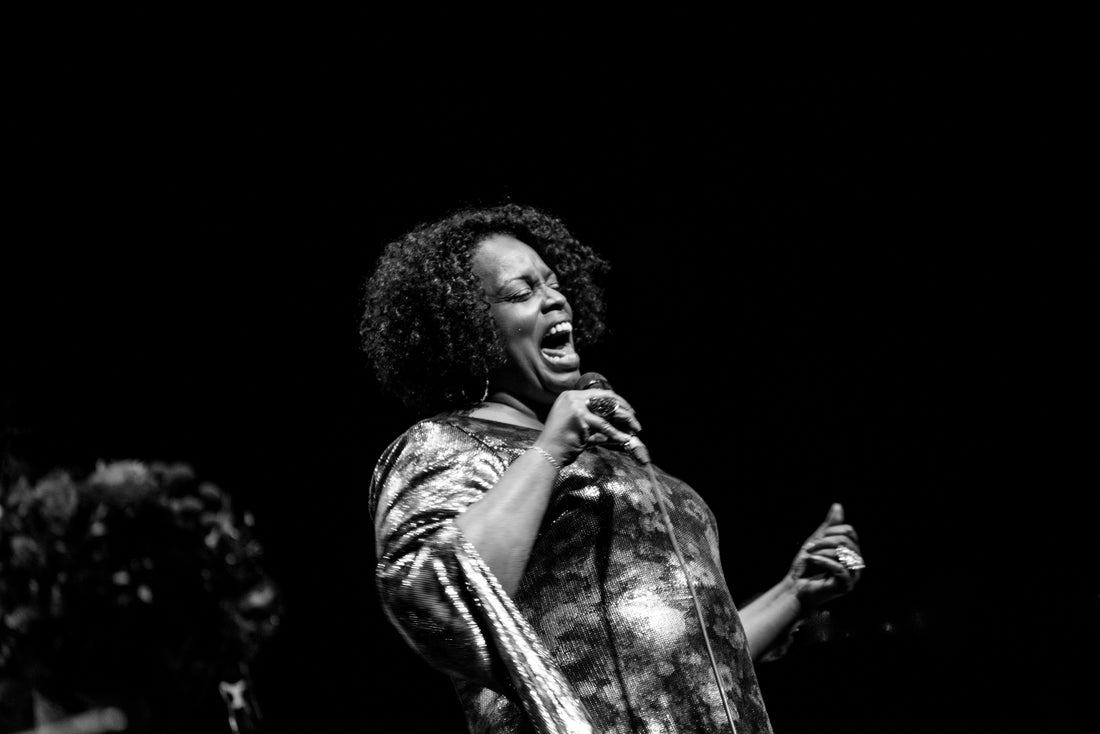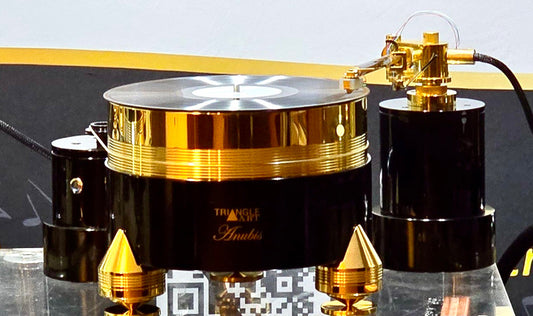When Dianne Reeves went with her Denver high school big band to the National Jazz Educators’ Convention in 1974, she probably didn’t expect her career to suddenly take flight. But among those who heard the teen sing there was trumpeter Clark Terry. He knew he was witnessing a major talent, and he helped her get a foothold in the most practical way, by inviting her to perform with him on some gigs. At one of them, the wide-eyed girl got to open for her hero, Sarah Vaughan, who was reportedly not just impressed, but threatened!
In 1976, at the age of 20, Reeves moved to L.A. There she studied voice with pianist/arranger Phil Moore, whose resume as a Hollywood vocal coach included work with Dorothy Dandridge and Marilyn Monroe. Reeves also sang with everyone who’d let her. She learned about Latin and funk by hanging with keyboardist Eddie del Barrio (leader of the band Caldera), about Brazilian music on a tour with Sergio Mendes, and about African and Caribbean rhythms during several years of performing with Harry Belafonte.
Within a decade, Reeves had established her place in the upper echelon of female jazz singers, and in 1987 was offered a coveted contract with Blue Note Records. Before that, she’d made a few albums on the Palo Alto Jazz label, highlights of which were subsequently re-released on Blue Note as The Palo Alto Sessions, 1981-1985.
Reeves is still an active performer, playing jazz festivals around the world. If you get a chance to hear her live, grab it. Until then, enjoy these eight great tracks by Dianne Reeves.
- “Sky Islands”

Dianne Reeves
Blue Note
1987
The opening track on Reeves’ Blue Note debut immediately establishes her as a jazz artist with classic chops but contemporary sensibilities and a knowledge of world music. Freddie Washington’s funky bass underlies an Afro-Brazilian beat spun out by Paulinho Da Costa on percussion.
Things to notice about Reeves’ voice, which are true whether she’s singing synth fusion like this or the standards she loves: 1) she never over-sings; 2) she has a massive range, which she can jump around as if it’s all equally accessible to her; and 3) her intonation is perfect.
- “Fumilayo”

Never Too Far
EMI
1989
“Fumilayo” is an African-tinged Latin jazz track composed by Reeves along with multi-instrumentalist George Duke. Reeves wrote the words, a call for hope and peace (“fumilayo” is slang for a friendly, joyous person). Luis Conte provides percussion this time.
The interesting thing here is the focus on the lower middle of Reeves’ range. That’s where her greatest power and most interesting textures lie. Hers is a vocal type associated more with swing/bop than Latin. It makes for a fascinating combination.
- “Sing My Heart”

Quiet after the Storm
Blue Note
1994
Because of her control over her voice, Reeves’ excels at contemplative pieces like this one. “Sing My Heart” is actually a 1939 Harold Arlen number, but David Torkanowski’s piano arrangement pushes it forward fifty years. The bowed bass-playing by Chris Severin contributes to keeping this version in the jazz realm, when it’s right at the precipice of pop.
But mostly, Reeves’ delivery is what makes this a great track. It’s an emotional conundrum: Off-hand in a way, but she’s concentrating deeply. Low-key in a way, but her anguish is on her sleeve.
- “Tenderly”

The Grand Encounter
Blue Note
1996
Despite her re-imagining of classics and love of contemporary jazz, Reeves is arguably at her finest when she’s singing jazz standards in a retro style. The first voice you’ll hear on this performance of “Tenderly” is that of Joe Williams; at age 77, he was an authentic link back to swing’s Golden Age. Harry “Sweets” Edison’s trumpet and Phil Woods’ alto sax make this an exquisite trio of soloists. Do listen all the way to that deliciously dissonant final chord, both singers at the very top of their ranges yet still subdued.
- “Dark Truths”

That Day
Blue Note
1997
“Dark Truths” is a 1988 song by indie pop singer Joan Armatrading. The contemplative sadness of the lyrics is ideal for Reeves’ penchant for quiet emoting.
Reeves puts a premium on clarity, singing the melody as simply as possible and with heartbreaking patience. Rather than improvise or decorate the vocal line, she lets pianist Mulgrew Miller add the jazz flourishes. This track is also one of many examples of Reeves hiring female artists –and particularly women of color — to work with. The drums are played here by Terri Lyne Carrington.
- “Fascinating Rhythm”

The Calling: Celebrating Sarah Vaughan
Blue Note
2001
Talk about a double helping of classic: Here’s a Gershwin song performed in tribute to Sarah Vaughan. This Grammy-winning album uses a full orchestra, conducted by Billy Childs, who also wrote the arrangements. Childs and Reeves go way back to the days when she first moved to L.A.
The arrangement takes a true be-bop approach to the well-known standard, never letting us hear it straight up – “Fascinating rhythm” is embedded in our ear like a Platonic form before the performance even starts, so why do it the way we expect?
It’s always a treat to hear Reeves scat. Like this record’s honoree, Reeves is always in precise control of her pitch and rhythmic articulation, two requirements for scat-mastery.
- “There’ll Be Another Spring”

Good Night and Good Luck
Concord
2005
The movie Good Night and Good Luck, written and directed by George Clooney, is about American TV news journalist Edward R. Murrow. There’s a lot to recommend this film, including the gorgeous and witty soundtrack by Dianne Reeves (who also appears in the movie as a singer). This album brought Reeves her second Grammy in a row.
Composed by Hubie Wheeler and Peggy Lee, “There’ll Be Another Spring” was recorded by Lee and pianist George Shearing in 1959. Quibblers might call foul, since that’s a few years too late for the movie’s story. But not only does it evoke the Fifties musically, it also has lyrics about hope during a time of sorrow and hardship – in this case, the McCarthy Era. The languid sax playing is by Matt Catingub.
- “Stormy Weather”

Beautiful Life
Concord
2014
For the last track, let’s circle back around to Harold Arlen, a composer Reeves has recorded many times. This is on her last studio album to date.
“Stormy Weather” has quite a history of stellar treatments by great female jazz singers. Reeves and Dutch musician Tineke Postma on soprano sax turn it into a mournful and moving duet. The famous melody reappears in fragments throughout Reeves’ harmonic meandering, as if she’s looking for the answer to why love has to hurt so much.



